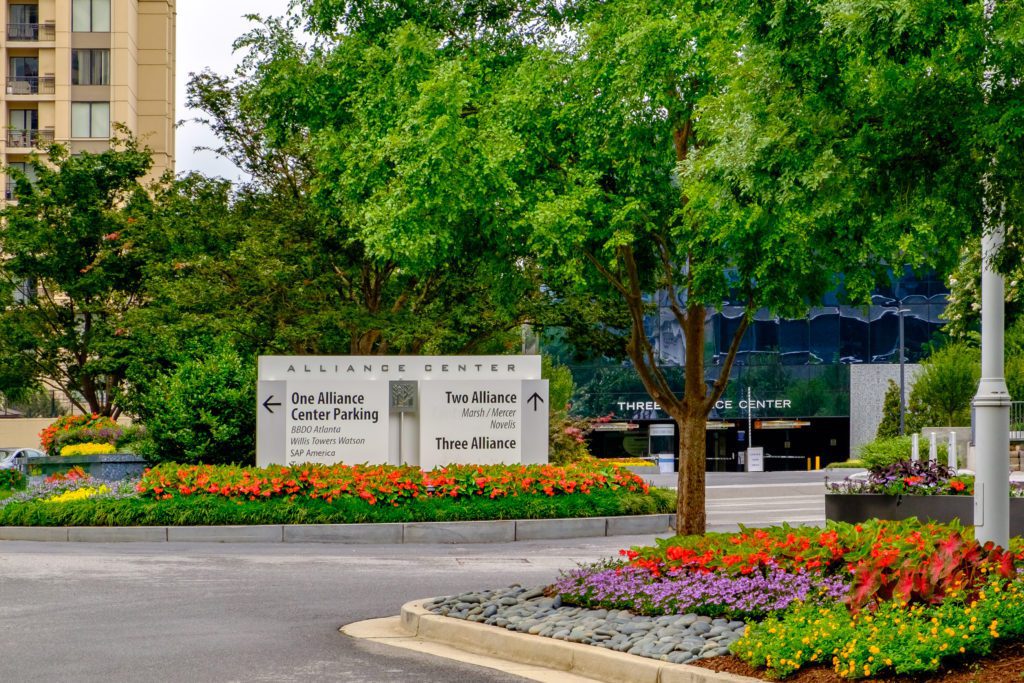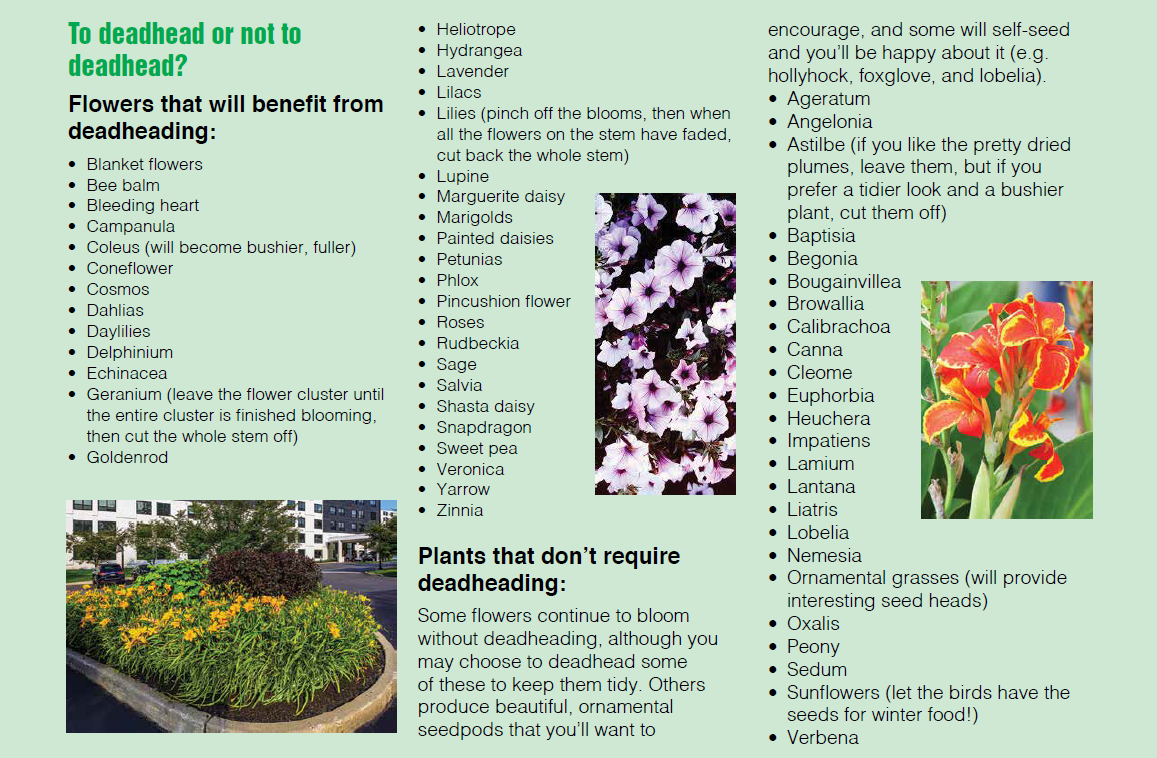 By Rachel Kelly, Branch Manager, Charlotte (NC)
By Rachel Kelly, Branch Manager, Charlotte (NC)
Summer is in full bloom! Literally: our seasonal color beds are popping with amazing color bringing much needed joy to our customers and the communities we serve. Typically installed in May (depending on the weather/region), these bright annuals will offer visual appeal throughout the summer—if properly cared for—until they are replaced with fall annuals in September/October.
Here are five keys to a successful maintenance program to keep our flower beds blooming all season long:
 Water! Water! Water! When asked what the most important thing is to know about planting trees, Ken Thompson (my counterpart in our landscape construction division) will respond, “planting height.” When asked what the second most important thing is to know about planting trees, his response is “planting height.” And the third most important thing? You got it, planting height. Well, for seasonal color beds my response is similar: I say “water, water, water.” Proper bed preparation, installation and mulching of the beds are all designed to encourage strong root growth which leads to big, beautiful flowers. But on top of that, it is critical to actively manage bed irrigation programs. Improper watering can ruin all our hard work. If our plants do not get enough water, roots shrivel up and the plants die of thirst. If they get too much water, the ground becomes saturated, and roots can’t pull oxygen from the soil and the plants suffocate. This shows up in the form of yellowed leaves and root rot. To reduce the risk of fungal infections, use soaker irrigation and avoid overhead watering whenever possible.
Water! Water! Water! When asked what the most important thing is to know about planting trees, Ken Thompson (my counterpart in our landscape construction division) will respond, “planting height.” When asked what the second most important thing is to know about planting trees, his response is “planting height.” And the third most important thing? You got it, planting height. Well, for seasonal color beds my response is similar: I say “water, water, water.” Proper bed preparation, installation and mulching of the beds are all designed to encourage strong root growth which leads to big, beautiful flowers. But on top of that, it is critical to actively manage bed irrigation programs. Improper watering can ruin all our hard work. If our plants do not get enough water, roots shrivel up and the plants die of thirst. If they get too much water, the ground becomes saturated, and roots can’t pull oxygen from the soil and the plants suffocate. This shows up in the form of yellowed leaves and root rot. To reduce the risk of fungal infections, use soaker irrigation and avoid overhead watering whenever possible. Feed your Flowers: Flowers need lots of energy to produce big, beautiful blooms. We help them along with a solid fertility program. Raleigh-Durham’s resident fert expert, Will Charping (pictured right), suggests using BullDog 20-20-20 once per month during the blooming season. It has good levels of NPK as well as a great array of micronutrients for complete fertility.
Feed your Flowers: Flowers need lots of energy to produce big, beautiful blooms. We help them along with a solid fertility program. Raleigh-Durham’s resident fert expert, Will Charping (pictured right), suggests using BullDog 20-20-20 once per month during the blooming season. It has good levels of NPK as well as a great array of micronutrients for complete fertility.- Weed Management: Weeds are a landscaper’s worst nightmare, especially when it comes to seasonal color beds. Applying preemergent weed control, such as Snapshot, during installation, will suppress weeds so you can spend more time on other tasks such as deadheading. Remember, big healthy plants are the best weed prevention!
- Deadheading: Annuals live to flower quickly, produce seed and die. Our goal is to keep the plant flowering as long as possible by preventing it from setting seed. Deadheading is the process of pinching, snapping or cutting the flowers just as they begin to fade. Deadheading gives us the immediate benefit of a neater and more pleasing appearance. It also provides us with a longer bloom season by forcing the plant to continue to spend energy on producing flowers instead of producing seeds for reproduction. Be sure to remove the entire flower, not just the petals.

- Pest Control: An ounce of prevention is worth a pound of cure. Actively managing water, food, and growth creates an optimal growing environment for our flowers and a suboptimal environment for pests. However, even the best management programs can see outbreaks of fungus, insects, and mites. But be judicious in your approach to treating pests; many of the treatments indiscriminately target pests and our pollinator friends, such as the honeybee, can be hurt in the process of getting rid of the pest. Planting native perennials elsewhere on the property can help provide a safe alternative for pollinators.
Follow these simple steps to ensure bright, healthy blooms all summer long!
 Water! Water! Water! When asked what the most important thing is to know about planting trees, Ken Thompson (my counterpart in our landscape construction division) will respond, “planting height.” When asked what the second most important thing is to know about planting trees, his response is “planting height.” And the third most important thing? You got it, planting height. Well, for seasonal color beds my response is similar: I say “water, water, water.” Proper bed preparation, installation and mulching of the beds are all designed to encourage strong root growth which leads to big, beautiful flowers. But on top of that, it is critical to actively manage bed irrigation programs. Improper watering can ruin all our hard work. If our plants do not get enough water, roots shrivel up and the plants die of thirst. If they get too much water, the ground becomes saturated, and roots can’t pull oxygen from the soil and the plants suffocate. This shows up in the form of yellowed leaves and root rot. To reduce the risk of fungal infections, use soaker irrigation and avoid overhead watering whenever possible.
Water! Water! Water! When asked what the most important thing is to know about planting trees, Ken Thompson (my counterpart in our landscape construction division) will respond, “planting height.” When asked what the second most important thing is to know about planting trees, his response is “planting height.” And the third most important thing? You got it, planting height. Well, for seasonal color beds my response is similar: I say “water, water, water.” Proper bed preparation, installation and mulching of the beds are all designed to encourage strong root growth which leads to big, beautiful flowers. But on top of that, it is critical to actively manage bed irrigation programs. Improper watering can ruin all our hard work. If our plants do not get enough water, roots shrivel up and the plants die of thirst. If they get too much water, the ground becomes saturated, and roots can’t pull oxygen from the soil and the plants suffocate. This shows up in the form of yellowed leaves and root rot. To reduce the risk of fungal infections, use soaker irrigation and avoid overhead watering whenever possible. Feed your Flowers: Flowers need lots of energy to produce big, beautiful blooms. We help them along with a solid fertility program. Raleigh-Durham’s resident fert expert, Will Charping (pictured right), suggests using BullDog 20-20-20 once per month during the blooming season. It has good levels of NPK as well as a great array of micronutrients for complete fertility.
Feed your Flowers: Flowers need lots of energy to produce big, beautiful blooms. We help them along with a solid fertility program. Raleigh-Durham’s resident fert expert, Will Charping (pictured right), suggests using BullDog 20-20-20 once per month during the blooming season. It has good levels of NPK as well as a great array of micronutrients for complete fertility.